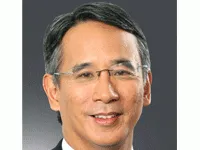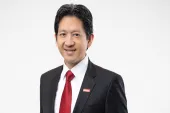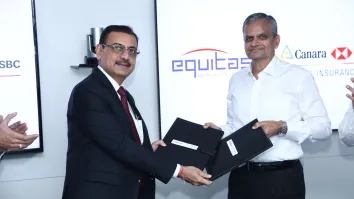
BPI: Redefining opportunities
Bank of the Philippine Islands prioritised liquidity over market share last year in anticipation of a difficult environment after the unprecedented shakeout in Wall Street. But from this year onwards, Southeast Asia's oldest bank is going after consumers as well as micro and small and medium enterprises (SMEs) in a big way.
Going back to basics is still its battlecry but the Philippines' most profitable bank seeks to "redefine opportunities" given cutthroat competition. It is casting a wider net by going "down market," knowing that it's the only way to broaden market base in an environment where top-tier corporations are increasingly turning to the burgeoning bond market for their funding needs.
"We see the opportunity to go after more customers in a broader deeper market which we call the underbanked Filipinos. In the end, our mission is to make BPI more accessible, more convenient and more cost-effective to more Filipinos," BPI president Aurelio Montinola III said.
BPI hopes to eventually generate half of its business from lending to the micro, SME and consumer sectors, which currently account for 39 percent or about P130 billion of the group-wide loan book.
"We feel we must proceed in a diversified and prudent lending manner this year…In not so many words, we are systematically going down market. In the 1980s, we went into family bank and consumer (banking) and in the 1990s, started going quietly into SMEs. This year, we're after the micro- market," Montinola said.
Part of the strategy to expand the BPI group's three million customer base is to tap alternative distribution channels even when it is comfortable with its 809-domestic branch network. Early this year, the bank which is part of the diversified Ayala conglomerate, pioneered with its affiliates a mobile banking platform for the entrepreneurial poor. It created a new banking unit that rides on the wireless technology of Globe Telecoms. The new subsidiary - named "BPI Globe BanKO" and nicknamed "BanKO" which means "my bank" in Filipino - aims to provide lending and deposit-taking services to a magnitude of Filipinos who live on as low as $2-a-day and have no access to formal banking channels. Its operations were designed in such a way that the cost structure is much lower but nevertheless capable to handle small-sized transactions in high volume and for a reasonable price. As part of its strategy, it seeks to institutionalise the use of Globe's electronic cash or G-cash technology to facilitate the movement of cash in line with its banking operations.
BanKO lends on a wholesale basis to microfinance institutions (MFIs) and is also pilot-testing a direct retail lending framework. The wireless technology harnessed by this new banking model also offers a basic lending platform that requires no additional capital expenditure as well as a much reduced loan processing and disbursing time. BPI and Globe Telecom own 40 percent each of BanKO while parent conglomerate Ayala Corp. owns the remaining 20 percent.
With the launch of BanKO, BPI now covers all market segments in micro and SME lending. The main universal bank BPI focuses on medium enterprises, thrift bank BPI Family Savings Bank unit caters to micro and small enterprises with less loan requirement. The group is also serious in boosting its presence in the provincial areas via its various banking units. On the retail side, BPI is also the biggest banking channel for overseas Filipino remittances. In 2006, it created BPI Direct Savings, a web-based bank for overseas Filipinos.
"We are really promoting the alternative channels. We have records showing that in 2003, 50 percent of transactions were done in the branches but in 2009, 60 percent of the transactions were done outside the branches. I guess the ATMs (automated teller machines) now handle about 50 percent of the transactions and we now have 12-13 percent of transactions in the self-service (Internet and mobile phone) channels," Montinola said.
BPI's new thrust is evident in its recent corporate communications. A new television ad, for instance, actively promotes mobile banking as part of daily life by featuring two young men who were making a silly bet and putting money down on the table using electronic cash.
Part of its basic thrust is to boost the cross-selling of products across branches. While BPI's insurance unit Ayala Life Assurance Inc. has made very little headway in the life insurance business in recent years compared to its competitors, for instance, this is seen dramatically changing with its new bancassurance tie-up with the market leader Philippines American Life and General Insurance Co. (Philamlife). Previously owned by the beleaguered AIG group but recently acquired (as part of a bulk buyout of Asian assets) by British financial giant Prudential, Philamlife bought 51 percent of BPI's Ayala Life Assurance Inc. to create the now closely watched new bancassurance partnership BPI-Philam Life Assurance.
BPI, the country's third largest bank in assets but the most valuable in terms of market capitalisation, is also working to build up its low-cost deposit base to fund the expansion in earning assets. "We've been asked before that if interest rates drop so low and there's roughly maybe one-third of our branches becoming unprofitable, then do we close them? We said no; we believe we're investing in the future - the thrust is to get additional customers who can fill these less profitable branches," Montinola said.
Last year, BPI's deposit base grew by 7 percent, outpacing the 2 percent growth in loans, as it focused on generating low-cost deposits and launched innovative products such as savings products bundled with free insurance. Low-cost current account and savings deposits now account for majority or 54 percent of BPI's total deposit base from 47 percent in 2008.
BPI has built a formidable banking empire since 1852 when the Philippines was still under Spanish colonial rule through both internal expansion and acquisition growth. Its last acquisition, however, was way back in 2005 with the buyout of the 100-branch Prudential Bank while more aggressive rival Banco de Oro Unibank has been gobbling up one bank almost each year since the turn of the century to catapult itself to the top of the banking game.
"We believe we're doing quite well on the organic side. I think the beauty of moving on an organic growth side is that you have a lot of freedom to go to all of the areas that you wish to do and I think the records show that this has paid off for us," Montinola said. "On the other hand, you know what our record is. We're always on the lookout for opportunity if something emerges. We run the bank thinking organically and if something else comes us, we consider it," he said.
BPI is also taking precaution that this strategy of going down-market will not gnaw at its balance sheet. Montinola said the bank is currently working on its internal capital adequacy assessment process (ICAAP), the process carried out by banks in determining what they think is the appropriate level of capital to hold.
Tailored to a bank's circumstances and needs, ICAAP goes beyond the credit risk, market risk and operational risk that are factored in the minimum capital adequacy ratio of 10 percent. The risk assessment must now consider risks not captured and not fully captured by the current capital framework such as credit concentration risk and those posed by contingent exposures.
BPI, which performed well even during the 2008 shakedown because it had no exposure to the once-venerable investment bank Lehman Brothers that collapsed during the US subprime crisis, is also continuing its stress-testing even when the worst of the global crunch. "If we go by out budget, we'll have enough capital until 2012 to stay above minimum regulatory requirement," Montinola said. That is, unless there is excessive volatility in the exchange rate and interest rate which is a remote possibility, he added.
The bank's capital adequacy ratio, a measurement of the capability of its capital funds to cover business risks, stood at 14.7 percent at end-2009 compared to the 10-percent minimum requirement. Non-performing loans as a ratio of total loan book stood at a very manageable 2.8 percent, of which 87.3 percent had been covered by reserves.
The bank also registered an improved operating efficiency, with the cost-to-income ratio declining to 57.2 percent in 2009 from 61.5 percent a year ago. Despite a slightly lower net interest margin or the ratio of net interest income to interest-bearing expense of 3.7 percent from 3.8 percent, BPI's return on equity grew to 13 percent last year from 10 percent in 2008.
The two-pronged strategy of going back to basics and redefining opportunities this year is expected to further improve returns this year. BPI sees net profits growing by at least 10 percent to as high as 15 percent over last year's net profit of P8.5 billion. "It will also depend partly on conduct of the elections. If the elections are peaceful and orderly, we will have an opportunity to grow our net income by up to 15 percent and if not, then we will be more cautious and go with our usual 10 percent (profit growth) goal," Montinola said.
BPI likewise expects to grow SME and consumer lending by 10-15 percent. The loan book to the top tier and multinational corporations is projected to grow at a slower pace of 5-10 percent this year.
Judging by the initial indications for credit requests in the first quarter, he said there seemed to be greater appetite for spending as well as business expansion this year. "I think in general, business volume in the first quarter has been surprisingly strong. We have said people will be cautious because of the elections but mood seems to be positive," he said.
The expected unwinding of interest rates by the local central bank is seen constraining treasury profits this year, but BPI avoids dependence on proprietary profits in the first place. "In the years that lending does well, treasury does a bit less and vice versa," Montinola said. "BPI, through its diversification, can operate with either low or high interest rates. We've already weathered the toughest of that last year."
So which businesses will likely do well this year? "At BPI we always have eight horses in play and we never know which two will do well or won't do as well," Montinola said. But offhand, he said the credit card and asset management businesses would likely continue their strong momentum. "On overseas side, as you move people from being remitters to become savers, you're able to increase profits," he said. "On investment banking, hopefully if elections are peaceful and orderly, there will be again tremendous interest on the Philippines and I foresee (that) there will be a lot of investment banking deals," he said.
"This year, we will promote BPI as the place to save and invest, cross sell asset management, credit card and bancassurance products," he said.


















 Advertise
Advertise










